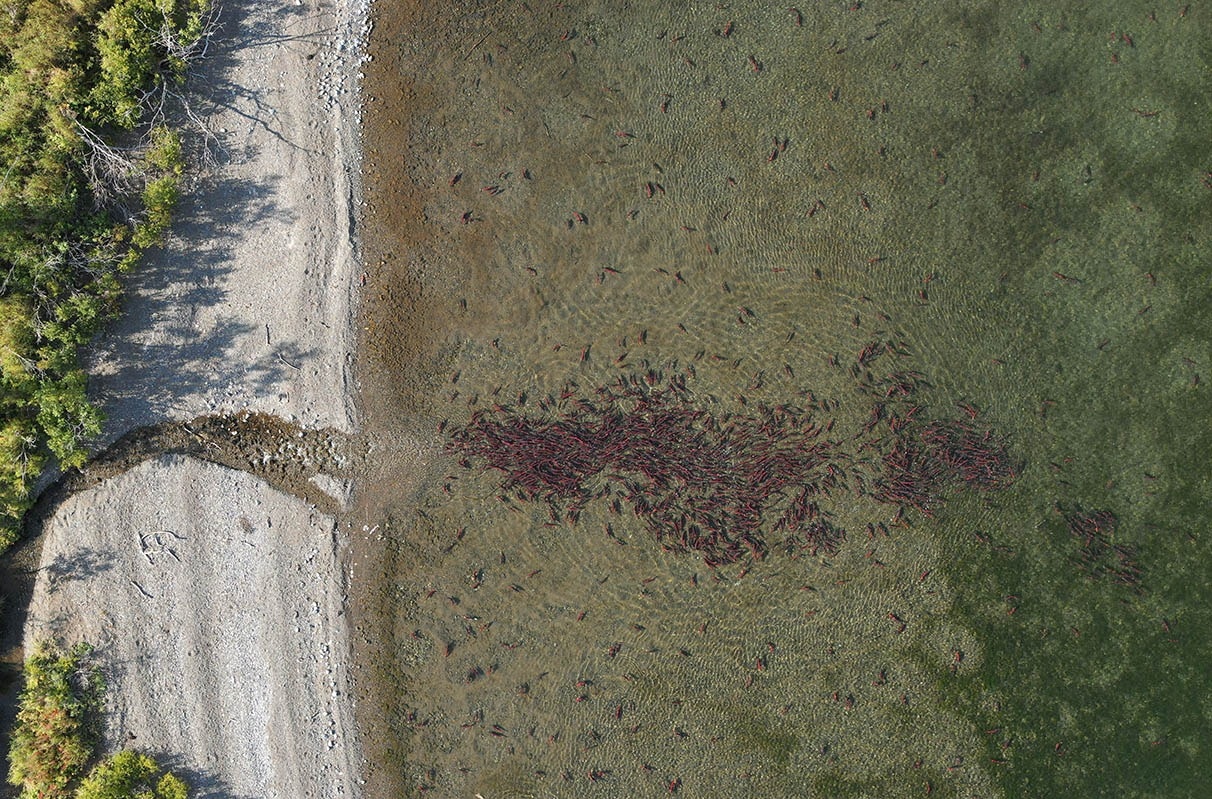A study at Washington State University (WSU) revealed that photos of the Wenatchee River during spawning season captured by a drone could effectively approximate the number of rocky hollows salmon build to lay their eggs, also referred to as “redds.”

A drone image of salmon during spawning season in Alaska. Image Credit: Daniel Auerbach.
Compared to ground-level observations, the drone imagery seemed to discover approximately twice the number of potential redds, but ambiguity remains because of the continuing difficulty of establishing what is and is not a real redd. Other than dismantling the nest, there are no other means to know for certain if the eggs of the salmon are present.
Nevertheless, the study presented some benefits to using drones, said Daniel Auerbach, the study’s lead author in the journal River Research and Applications.
There’s no denying that salmon populations are in decline, so we want to do the best job and use the best technology that we can to help this species out. While ground redd counts are less intrusive than other counts, drones are even less invasive, and we can use these images for many things.
Daniel Auerbach, Study Lead and Doctoral Candidate, Washington State University
Besides a one-time count, scientists can use drone imagery to observe variations in the environment over time, including mitigations humans have set up to help salmon, which range from cultivating shrubs to getting rid of entire dams.
These technologies will give us more data to really find out if what we’re doing is working. A drone provides a bird’s eye view and high-resolution images. Because we can get so much information from these images, we could be more cost-effective and help determine if a restoration project helped build salmon habitat.
Alex Fremier, Study Co-Author and Associate Professor, School of the Environment, Washington State University
Salmon are famous for their ambitious upstream journeys to return to areas they were born to lay their eggs. Female salmon will push away rocks to lay their eggs, and then the males fertilize them. The female salmon are frequently known to protect the eggs in these redds until they die.
Existing methods of totaling redds include field biologists floating downstream in a boat or walking lengths of a river. A few places employ helicopters to allow researchers to observe aerially, which can be hazardous in steep canyons.
For this research, Auerbach and Fremier worked with the Washington Department of Fish and Wildlife field biologists to locate three areas along the main stem of the Wenatchee River that are famous for the density of redds.
Once a week, during the Chinook spawning season of September through November 2020, the researchers flew a drone around 150 feet above those locations to capture images. Skilled observers would then count redds based on those images.
The Washington Department field biologists also frequently embark on an arduous weekly ground count in these locations, offering a worthy comparison.
The observers using the drone imagery discovered approximately twice the number of redds compared to those on the ground, but there were wide inconsistencies of plus or minus 80 redds among the human observers. This inconsistency is not uncommon because salmon occasionally start a nest but desert it for a better place, and these false starts can mess up the counts by any technique.
Auerbach and Fremier emphasized that drones can supplement but probably not substitute the boots-in-the-water count as field biologists will always be necessary. However, Auerbach explained that drones have certain benefits such as a wider field of view and the ability to shift between images.
The scientists will carry on exploring ways to employ drones to help salmon. They are presently examining data from a second study on the Wenatchee in 2021 in partnership with Katy Shelby of the Washington Department of Fish and Wildlife.
Auerbach also recently conducted a study in Alaska using drones to quantify sockeye salmon. The images captured were so clear they could even detect whether a fish was male or female by size.
Journal Reference:
Auerbach, D.S & Fremier, A.K. (2022) Identification of salmon redds using RPV-based imagery produces comparable estimates to ground counts with high inter-observer variability. River Research and Applications. doi.org/10.1002/rra.4065.